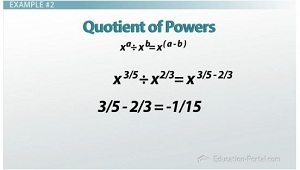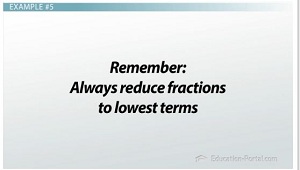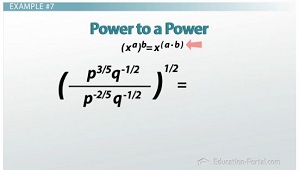Simplifying Expressions with Rational Exponents
After you watch the video and know the material, click HERE for the quiz.
Simplifying expressions with radical exponents is so easy. In fact, you already know how to do it! We simply use the exponent properties but with fractions as the exponent!
Expressions with Rational Exponents
Rational exponents follow exponent properties except using fractions.
Review of exponent properties - you need to memorize these. Just can't seem to memorize them? Have you tried flashcards? They work fantastic, and you can even use them anywhere!
- Product of Powers: x^a*x^b = x^(a + b)
- Power to a Power: (x^a)^b = x^(a * b)
- Quotient of Powers: (x^a)/(x^b) = x^(a - b)
- Power of a Product: (xy)^a = x^ay^a
- Power of a Quotient: (x/y)^a = x^a / y^a
- Negative Exponent: x^(-a) = 1 / x^a
- Zero Exponent: x^0 = 1
Putting the exponent rules to work with exponent properties...
Example #1
y^(1/2) * y^(1/3)
For this one, we're going to follow the product of powers. Remember, when we multiply, we add their exponents.
1/2 + 1/3 = 5/6
So the answer is going to be y^(5/6).
Example #2
Simplify: x^(3/5) / x^(2/3)
 |
For this one, we're going to use the quotient of powers. Remember, when we divide, we subtract their exponents. So, we're going to have:
x^(3/5 - 2/3)
3/5 - 2/3 = -1/15
So our answer is x^(-1/15).
Example #3
Simplify: x^(-2/7)
For this one, we're going to use the negative exponents property. Remember, when we have a negative exponent, we flip it. If it's in the numerator, we flip it to the denominator, which is in this case.
So our answer is going to be 1 / (x^(2/7)).
Example #4
Simplify: (x^(4/5))^(3/4)
In this one, we have power to a power. We're going to have (x^(4/5))^(3/4), so we're going to multiply 4/5 * 3/4 which is 12/20. We need to reduce our fractions when we're going to get our final answer. 12/20 reduces to 3/5.
So our answer is going to be x^(3/5).
Example #5
 |
Putting multiple exponent rules to work with exponent properties... Simplify using positive exponents. Always reduce the fractions to lowest terms.
((p^(1/2)q^3)^(2/3)) / (( pq)^(1/2))
First we're going to simplify the power to a power. So now we'll have:
(p^(2/6)q^(6/3)) / (p^(1/2)q^(1/2))
Write like terms over each other, if necessary. Well, we already have the p's over the p's and the q's over the q's. There's no need to simplify fractions now. We're going to go right to simplifying quotient of powers. Remember, when we divide, we subtract their exponents. So we have:
p^(2/6 - 1/2) * q^(6/3 - 1/2)
That gives us:
p^(-1/6) * q^(9/6)
Next we need to reduce the fractions because we're almost to our answer. So we'll have:
p^(-1/6) * q^(3/2)
We want to rewrite these using positive exponents. Remember, if it's negative in the numerator, it flips to the denominator. So our final answer's going to be:
q^(3/2) / p^(1/6)
Example #6
Simplify using positive exponents. Always reduce the fractions to lowest terms. We're going to have:
((2m^(2/3))^3 / (8m^(1/6))^2
We're going to simplify power to a power. So we'll have:
2^(3)m^(6/3) / 8^2m^(2/6)
Remember, power to a power means to multiply the exponents. Next, let's write like terms over each other. We already have 2^3 over 8^2 and m^(6/3) over m^(2/6). So let's move to the next step. There's no need to simplify fractions just yet, so we're going to simplify quotient of powers. Remember, when we divide, we subtract. So now we're going to have:
8/64 * m^(6/3 - 2/6)
Well, 8/64 is 1/8. m to the 6/3 - 2/6 is m to the 10/6. So it turns out that our final answer is:
m^(5/3) / 8
We won't touch the improper fraction in this video. We're just simplifying rational exponents.
Example #7
Simplify using positive exponents. Always reduce fractions to lowest terms.
((p^(3/5)q^(-1/2) / ( p^(-2/5)q^(-1/2))^(1/2)
 |
First we're going to simplify power to a power. Remember, power to a power means to multiply the exponents. That'll give us:
(p^(3/10)q^(-1/4)) / (p^(-2/10)q^(-1/4))
Next, if we need to, write like terms over each other. There's no need to simplify fractions now. We're going to move to quotient of powers. Remember, when we divide, we subtract their exponents. So that's going to give us:
p^(3/10 - (-2/10))q^(-1/4 - (-1/4))
So let's keep simplifying.
p^(5/10)q^(0)
The zero exponent says q^0 equals 1. Now we need to reduce our fraction 5/10. That's going to give us our answer:
p^(1/2)
Radical to Rational Fraction Formula
Review radical to rational fraction formula...
 |
The bth root of x^a = x^(a/b)
The index is the denominator. The exponent is the numerator. What happens when the expression has radicals?
- Change the radicals to rational exponents
- Follow exponent rules
Example #8
(third root of x)(fifth root of x^4)
First we need to change to rational exponents, so we're going to have:
x^(1/3) * x^(4/5)
Did you remember the denominator is the index number and the numerator is the radicand exponent? Following our exponent rules, we're going to do a product of powers. Remember, when we multiply, we add their exponents. So we're going to have:
x^(1/3 + 4/5)
Well, 1/3 plus 4/5 is 17/15. So our answer's going to be:
x^(17/15)
Remember, we need to change the rational exponent back into a radical expression.
x^(17/15) = 15th root of x^17
Lesson Summary
Rational exponents follow the exponent rules. Remember to reduce fractions as your final answer, but you don't need to reduce until the final answer. For operations on radical expressions, change the radical to a rational expression, follow the exponent rules, then change the rational expression back to a radical expression.